Greer Gilman's Blog, page 5
July 15, 2021
The Sable Pimpernel
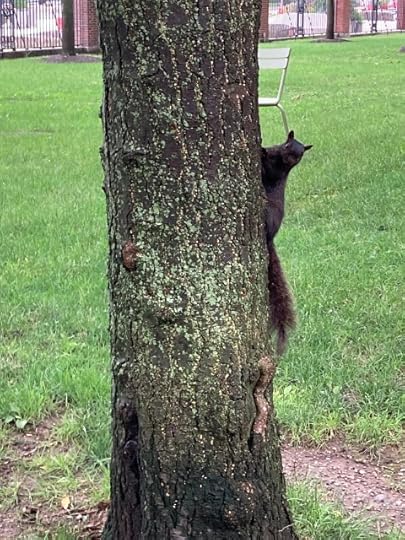
They seek him here, they seek him there.
Those Frenchies seek him everywhere.
Is he in hellfire or is he on high?
That demned elusive Écureuil.
Nine
Published on July 15, 2021 20:15
July 5, 2021
Fourthly
Fox and I built a mighty dam on the playground waterworks with what he called “marvellous mud” (at which I sang him “The Hippotamus Song”), defending it against “the 5053rd dastardly villain” to assail it. Dredging is deliciously messy work. So’s sluicing. The villain, a nice child who was pumping water for this Nile, then turned coat on herself and heaped sand on the bulwark against her own spate. Fox showed inklings of geological forces: “The water is melting the dam at the same time it’s building it.” The older child urged using drier sand. As a finishing touch, Fox turned the ziggurat into a poisoned cake for another, absent villain, with the addition of woodchip candles. Musingly, “Sand is more of a grindy food than a chewy food.”
Yes, I’ve noticed that at beach picnics.
I do love playing with running water—my own childhood had real brooks and a river with a mill dam—but most of all I like dismantling leaf-and-branch jams, especially when icebound. That propensity got into Moonwise.
On the way the way to my house afterward, Fox called chocolate and strawberry together in one pint “chimaera ice cream.” Now that’s a metaphor I wish I’d thought of! As he said of the ice cream, it’s “wondrously good.”
What else?
Right now, I’m reading Richard Mabey, The Ash and the Beech and Jonathan Bate, How the Classics Made Shakespeare. That first is on the ecological, economic, and aesthetic history of beeches (and more broadly, trees) in the British landscape. Just my sort of jam!
And in a way, the reading has been a private memorial for the great beech at Mount Auburn, which I dearly loved. It was a parkland tree, of course: solitary, cosseted, allowed to outwhorl itself in unimpeded space. For most of their existence in Europe, beeches have been pollarded or coppiced: endlessly cut down to the trunk or stump for firewood or poles. A renewable resource. But the scarring on scarring grows them into weird gargoyle shapes, which I’d never seen until I went to live in that other Cambridge.
No one in New England, drowning in a sea of woods, did that. We grubbed up stones and built walls of them, to mark the fields we’d cleared of trees to burn, to keep body and soul together through the winters, to grow alien corn amid a new crop of stones. My childhood woods were full of abandoned farmlands.
Humankind has been terraforming earth since we began to use tools.
Of course, the birds began ages before that. Did you know that jays instinctively bury acorns in excellent places for seedling oaks to grow? “The autumn total for the whole of Britain may be as high as one and half billion acorns.” They find their larders “easily, apparently using a grid of nearby vertical features as a three-dimensional map. In spring, they rely on the recognizable first leaves of the emerging oaklings as beacons, though ... adult jays ignore seedlings from acorns they haven’t planted themselves.” Most acorns “are never retrieved or are pushed back as unsuitable by the jays, and since they’re been planted expertly in well-nigh perfect conditions for an aspiring oak, large numbers germinate successfully. ... It wouldn’t be outrageous to suggest that the oak and the jay have evolved as symbiotic partners.”
Darwinian forces are really good at worldbuilding.
Bate’s book is about how Shakespeare’s imagination was archaeoformed by his boyhood (and ongoing) reading in the classics, by alien gods and myths and philosophies. Well, nativized myths: they co-existed with Christianity in a sort of lichen.* Everyone’s literary gardens grew Daphnes, Hyacinths, Anemones. Olympus nested in the trees of Arden.
Oh yes. It was the Fourth. Last year, the street bangs were incessant, all summer long. This year, the proper fireworks weren’t quite a wash. The rain, which began as a blessed relief from that appalling heatwave, had gone on and on all week. “My boots are full of Clyde water,” I’d say, and hang another pair of socks out over the tub. But on Sunday, after days of downpour, it had been nice enough to play outdoors: pleasantly coolish, fitfully overcast, with fleeting glimpses of sun. There even was a lovely clear sunset. I had hopes.
Of course, it started pouring cats and dogs again, right before the show. The city had moved the firing site, which blocked my view; the rain kept beating down the sparks; the fog was universal.
So from my rooftop, I looked out on a cityscape painted by a melancholic post-Impressionist. All sepia and subfusc, with a sputter of damp squibs.
Waves breaking in white spray upon a rockbound promontory.
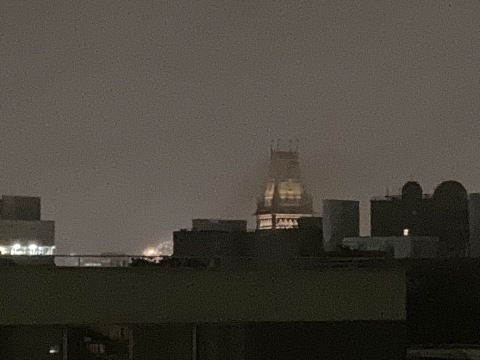
Low cloud redstained by rockets, eerily like a firewatch in an alternative Blitz.
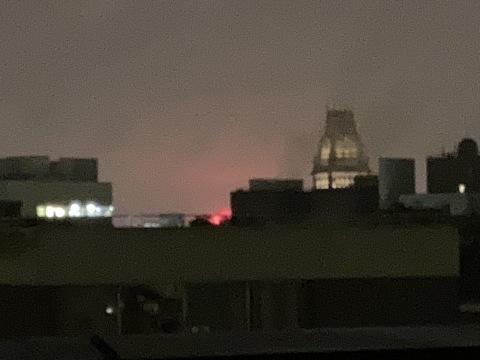
This image kept underlaying what I saw:

Oh no, they got the London Eye!
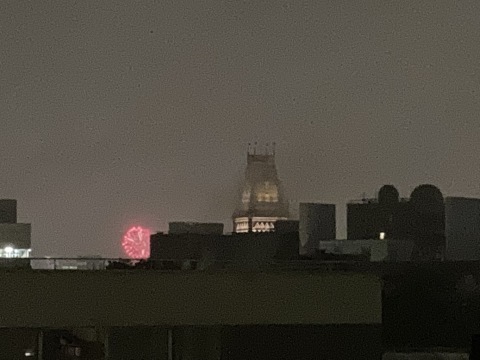
And sometimes, as the martial scarlets paled to pink, we got the march of the sakura Entwives.
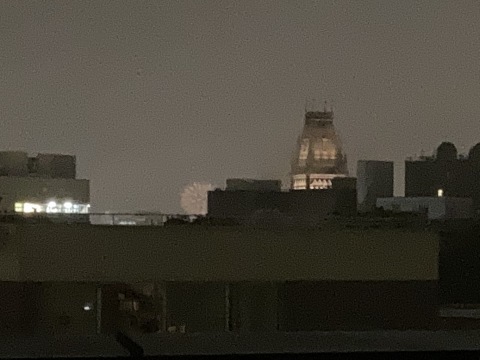
Nine
*Of course, Christianity is itself a lichen, living on and with the paganisms of whatever folk import it. The written and revived beliefs that came in with the Renaissance are a third symbiont. It's awfully complex. Perhaps the metaphor should be creolization?
9
Yes, I’ve noticed that at beach picnics.
I do love playing with running water—my own childhood had real brooks and a river with a mill dam—but most of all I like dismantling leaf-and-branch jams, especially when icebound. That propensity got into Moonwise.
On the way the way to my house afterward, Fox called chocolate and strawberry together in one pint “chimaera ice cream.” Now that’s a metaphor I wish I’d thought of! As he said of the ice cream, it’s “wondrously good.”
What else?
Right now, I’m reading Richard Mabey, The Ash and the Beech and Jonathan Bate, How the Classics Made Shakespeare. That first is on the ecological, economic, and aesthetic history of beeches (and more broadly, trees) in the British landscape. Just my sort of jam!
And in a way, the reading has been a private memorial for the great beech at Mount Auburn, which I dearly loved. It was a parkland tree, of course: solitary, cosseted, allowed to outwhorl itself in unimpeded space. For most of their existence in Europe, beeches have been pollarded or coppiced: endlessly cut down to the trunk or stump for firewood or poles. A renewable resource. But the scarring on scarring grows them into weird gargoyle shapes, which I’d never seen until I went to live in that other Cambridge.
No one in New England, drowning in a sea of woods, did that. We grubbed up stones and built walls of them, to mark the fields we’d cleared of trees to burn, to keep body and soul together through the winters, to grow alien corn amid a new crop of stones. My childhood woods were full of abandoned farmlands.
Humankind has been terraforming earth since we began to use tools.
Of course, the birds began ages before that. Did you know that jays instinctively bury acorns in excellent places for seedling oaks to grow? “The autumn total for the whole of Britain may be as high as one and half billion acorns.” They find their larders “easily, apparently using a grid of nearby vertical features as a three-dimensional map. In spring, they rely on the recognizable first leaves of the emerging oaklings as beacons, though ... adult jays ignore seedlings from acorns they haven’t planted themselves.” Most acorns “are never retrieved or are pushed back as unsuitable by the jays, and since they’re been planted expertly in well-nigh perfect conditions for an aspiring oak, large numbers germinate successfully. ... It wouldn’t be outrageous to suggest that the oak and the jay have evolved as symbiotic partners.”
Darwinian forces are really good at worldbuilding.
Bate’s book is about how Shakespeare’s imagination was archaeoformed by his boyhood (and ongoing) reading in the classics, by alien gods and myths and philosophies. Well, nativized myths: they co-existed with Christianity in a sort of lichen.* Everyone’s literary gardens grew Daphnes, Hyacinths, Anemones. Olympus nested in the trees of Arden.
Oh yes. It was the Fourth. Last year, the street bangs were incessant, all summer long. This year, the proper fireworks weren’t quite a wash. The rain, which began as a blessed relief from that appalling heatwave, had gone on and on all week. “My boots are full of Clyde water,” I’d say, and hang another pair of socks out over the tub. But on Sunday, after days of downpour, it had been nice enough to play outdoors: pleasantly coolish, fitfully overcast, with fleeting glimpses of sun. There even was a lovely clear sunset. I had hopes.
Of course, it started pouring cats and dogs again, right before the show. The city had moved the firing site, which blocked my view; the rain kept beating down the sparks; the fog was universal.
So from my rooftop, I looked out on a cityscape painted by a melancholic post-Impressionist. All sepia and subfusc, with a sputter of damp squibs.
Waves breaking in white spray upon a rockbound promontory.

Low cloud redstained by rockets, eerily like a firewatch in an alternative Blitz.

This image kept underlaying what I saw:

Oh no, they got the London Eye!

And sometimes, as the martial scarlets paled to pink, we got the march of the sakura Entwives.

Nine
*Of course, Christianity is itself a lichen, living on and with the paganisms of whatever folk import it. The written and revived beliefs that came in with the Renaissance are a third symbiont. It's awfully complex. Perhaps the metaphor should be creolization?
9
Published on July 05, 2021 20:51
June 30, 2021
Lift up your hearts
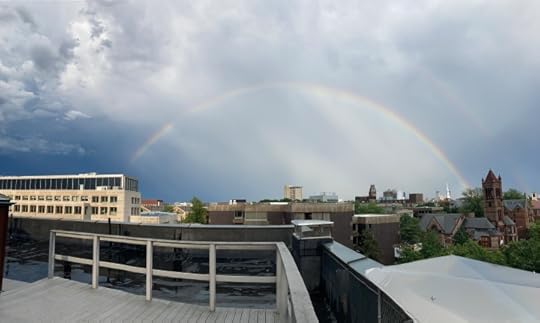
This.
Walked home against a bruise-black stormfront and a vast, uncompassed wind. Ran upstairs to the roof at once, just as a hail of rain was ending, and caught this faintly double bow.
As the first of its gifts of hope, it brought a respite from the heat wave, plummeting 24º F in no time. May all of you find such relief and uplift.
Nine
Published on June 30, 2021 16:14
June 29, 2021
Of Winter, cockatoos, and cake
Did you know there's a cockatoo in a Mantegna?
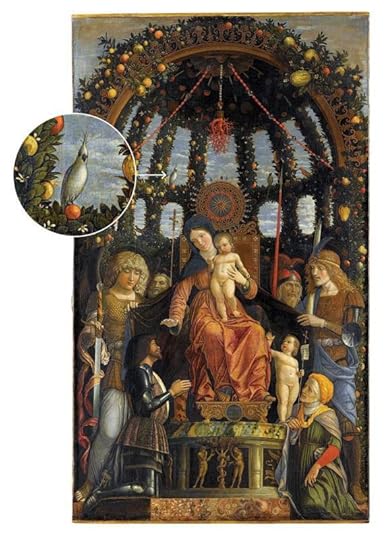
And another in a 13th-century manuscript on falconry by Frederick II? There's a lovely little piece in this week's New Yorker about far-travelled birds, on trade routes reaching into Australasia. And you thought the Pope's rhinoceros was the last word in princely one-upmanship!
Trust the Ozzies to chi-yike. "In Australia, one newspaper came up with the irresistible headline 'Picture Points to Renaissance Budgie-Smugglers.' (“Budgie-smuggler” is the preferred local term for a Speedo.)"
Still the journey astonishes. How far is Sulawesi from Sicily? Almost in another galaxy, "It’s tempting to imagine that the Emperor’s cockatoo learned greetings, or curses, in different languages during its journey; unfortunately, Frederick’s scribe failed to note any polyglot repertoire, which might have provided further clues about the bird’s path."
Speaking of galactic journeys, I was thrilled to see a poster in the PO for the new Ursula K.Le Guin stamp. I'm going to buy a quire of sheets when it's available.

Happily, I can slip into bookstores and bakeries now. Tatte makes a fabulous Pride Cake, with layers of almond frangipane and Valrhona chocolate, and such glorious clear intense colors! Every crumb in a good cause.


Nine

And another in a 13th-century manuscript on falconry by Frederick II? There's a lovely little piece in this week's New Yorker about far-travelled birds, on trade routes reaching into Australasia. And you thought the Pope's rhinoceros was the last word in princely one-upmanship!
Trust the Ozzies to chi-yike. "In Australia, one newspaper came up with the irresistible headline 'Picture Points to Renaissance Budgie-Smugglers.' (“Budgie-smuggler” is the preferred local term for a Speedo.)"
Still the journey astonishes. How far is Sulawesi from Sicily? Almost in another galaxy, "It’s tempting to imagine that the Emperor’s cockatoo learned greetings, or curses, in different languages during its journey; unfortunately, Frederick’s scribe failed to note any polyglot repertoire, which might have provided further clues about the bird’s path."
Speaking of galactic journeys, I was thrilled to see a poster in the PO for the new Ursula K.Le Guin stamp. I'm going to buy a quire of sheets when it's available.

Happily, I can slip into bookstores and bakeries now. Tatte makes a fabulous Pride Cake, with layers of almond frangipane and Valrhona chocolate, and such glorious clear intense colors! Every crumb in a good cause.


Nine
Published on June 29, 2021 01:16
June 21, 2021
Midsummer mizmaze
Belated wishes for a joyful Solstice.
Annoyingly, my WiFi, which had been drawling and stretching for weeks, fainted in coils. Much palaver with tech support, who kept telling me to do topologically impossible things with my Ethernet cable. I finally asked, How about that thing where you stab the router to the vitals with a paperclip? And then type in a limitless alphanumeric? That did work, thank heavens. but I'm feeling frazzled.
My signal had forgotten who it was, like Alice.
Let's pretend it's yesterday.
Hey. I got to play Puck in a Discord reading on Saturday! I wrote some light verses for an old friend's old character's solstitial birthday (he's a bad-boy Sun King), which she loved. There was a poster in the PO for a new Ursula K. Le Guin stamp! (Not out yet.)
Wishing you, dear friends. a lightsome Leapfire. You are on a hillside, deep in grass. Above, the Swan is diving through the Milky Way; below, the fireflies are sketching constellations, and the river runs.
Dream well.
Nine
Annoyingly, my WiFi, which had been drawling and stretching for weeks, fainted in coils. Much palaver with tech support, who kept telling me to do topologically impossible things with my Ethernet cable. I finally asked, How about that thing where you stab the router to the vitals with a paperclip? And then type in a limitless alphanumeric? That did work, thank heavens. but I'm feeling frazzled.
My signal had forgotten who it was, like Alice.
Let's pretend it's yesterday.
Hey. I got to play Puck in a Discord reading on Saturday! I wrote some light verses for an old friend's old character's solstitial birthday (he's a bad-boy Sun King), which she loved. There was a poster in the PO for a new Ursula K. Le Guin stamp! (Not out yet.)
Wishing you, dear friends. a lightsome Leapfire. You are on a hillside, deep in grass. Above, the Swan is diving through the Milky Way; below, the fireflies are sketching constellations, and the river runs.
Dream well.
Nine
Published on June 21, 2021 23:26
June 18, 2021
Summer time
The Liberty Puzzles queue is down to 5 days (from 68 at Christmas), and you can order TWO puzzles at a time, if you're lucky enough to afford them.
I'm not a lover of pink, but aren't these Matisse whimsies pretty? The reader on the couch is especially enchanting, but the patisserie, the lemonade (with slices), and the little blue-and-white jug with flowers are all delightful. I want to move in.
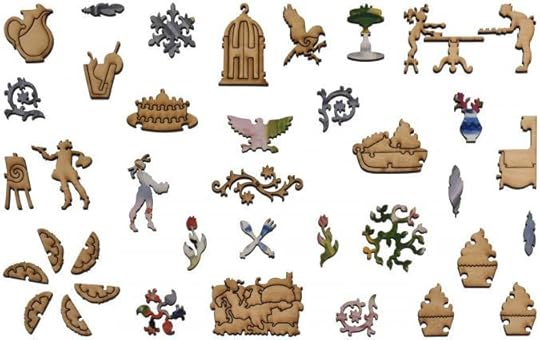
Nine
I'm not a lover of pink, but aren't these Matisse whimsies pretty? The reader on the couch is especially enchanting, but the patisserie, the lemonade (with slices), and the little blue-and-white jug with flowers are all delightful. I want to move in.

Nine
Published on June 18, 2021 22:40
June 15, 2021
Folklife
The Library of Congress is hosting Martin Carthy in concert today (Wednesday) at 12:45 PM EDT. It's part of a lovely series, all free, and all still available. I've listened to a few, and I especially enjoyed Iona Fyfe of Aberdeenshire, who has a gorgeous version of Child 264, "The White Fisher." This, by ballad standards, is a blaze of joy: a man discovers that his bride is with child by a kitchen boy; he takes the new-born child up, and we fear the worst; but instead of casting it in the sea, he presents it to his mother as his own bastard--only don't tell my wife. That, I think, is his master stroke: she loves this mother-son conspiracy against the interloping daughter-in-law, and she goes all grandmother-bear. The baby is well-nurtured; the wife is comforted. This totally flunks Ballad Bingo.
'O bonny was the white fisher
That ye kiest in the faem;
But lang, lang will I look for fish
Ere white fish he fetch hame!
My gosh, a government dispensing folk music. What world is this?
Nine
'O bonny was the white fisher
That ye kiest in the faem;
But lang, lang will I look for fish
Ere white fish he fetch hame!
My gosh, a government dispensing folk music. What world is this?
Nine
Published on June 15, 2021 23:55
June 10, 2021
Can we fix it?
So I have this part-time job finding places on maps. While researching a huddle of council housing for the elderly poor in heaven-help-us Watford, I found this unexpectedly touching note from the developer:
"During construction we also had to accommodate the careful relocation of slow worms from the site to a permanent new habitat, and monitor the presence of badgers after the discovery of a sett on the perimeter of the site."
Aww.
Only I hope that someone would take such tender care of the relocated pensioners. And now I'm thinking of Creature Comforts...
Nine
"During construction we also had to accommodate the careful relocation of slow worms from the site to a permanent new habitat, and monitor the presence of badgers after the discovery of a sett on the perimeter of the site."
Aww.
Only I hope that someone would take such tender care of the relocated pensioners. And now I'm thinking of Creature Comforts...
Nine
Published on June 10, 2021 00:58
May 30, 2021
May miscellany
And here at last, for those of you who missed it or would like to revisit, is the Handheld Book Club conversation on Sylvia Townsend Warner with myself and the excellent Ingrid Hotz-Davies, and Kate Macdonald moderating. The random madman who burst in has been edited out, thank heavens.
Remember my Boskone conversazione with Michael Swanwick? We talked about Townsend Warner, Stella Benson, P. L. Travers, Hope Mirrlees, and Tove Jansson. Most enjoyable. Marianne Porter has agreeably proposed to publish “The Lonely and the Rum” as a chapbook, so I spent several days turning all my ums and ers and grammarless babble into sentences. I’ve never had to edit what I actually say before, and it’s sobering how incoherent I sound to myself, with here and there a flash of inspiration.
(Hey, did any of you know there’s a Jansson biopic out there? Finnish not Hollywood, thank heavens. Anthony Lane liked it, but I’m afraid to look. I'd rather not see her life messed with)
Straight after I turned that transcript in, I was asked to do a Scintillation Discord, snarking on Oxfordians. I can do that without prompting, gleefully. To my delight, one of the other speakers was![[personal profile]](https://i.gr-assets.com/images/S/compressed.photo.goodreads.com/hostedimages/1491408111i/22407843.png) rushthatspeaks
on his 365 Books project. What a joy! If you haven't seen it,
rushthatspeaks
on his 365 Books project. What a joy! If you haven't seen it,
![[personal profile]](https://i.gr-assets.com/images/S/compressed.photo.goodreads.com/hostedimages/1491408111i/22407843.png) rushthatspeaks
read and reviewed a book a day for a year. Brilliant and various.
rushthatspeaks
read and reviewed a book a day for a year. Brilliant and various.
And still more writerly rush: I had to compose my panel-choices for Readercon, which essentially means guessing what shape a panel might take and then doing a bit of it, which is like auditioning for an unwritten play, or playing solo mixed doubles on a netless tennis court. Oof. There were two or three ravishing topics on offer, but we’re rationed to just one (if any at all) this year.
I’ve come far enough out of my pandemic hermitude to do play-readings over at the Scintillation Discord. So far I’ve been handed real plums: Thomasina in Act II of Arcadia, Margaret in Dear Brutus, and both Touchstone and Phebe. An idle conceit: Shakespeare’s plays were in conversation with other plays of the period, and I wonder if Audrey weren’t a parody of some grand Gothic tragedy queen?
Really, I tell myself, the pandemic has slowed down now, I can stop buying books and raising cromlechs and hill forts of them round me for protection, but irresistible titles keep turning up, books on the philosophy of color and celestial geometry and synesthesia and Greek amulets and the Annunciation in painting and butch and Bosch and William Morris’s Icelandic diaries.
Oh, and speaking of pre-Raphaelites, I’ve loved Three Houses, Angela Thirkell’s memoir of childhood, for absolute ages (keeping up with the Burne Joneses and the Kiplings), but I hadn’t read her Barsetshire novels. They’re all free on Faded Page, so I downloaded a bunch of the thirties ones. (I like digital books at meals, as it doesn’t matter if I slop sauce on them.) As many of you know, they are rather delicious: dry, gentle social satire, like cosies with marriages instead of murder.
And by the way, the grand-daughters of pre-Raphs do write some treasurable memoirs. Diana Holman-Hunt’s My Grandmothers and I gives us a twenties childhood, shunted between a country-house socialite too parodic even for the BBC and the painter’s mad, miserly, imperious relict. Here are the Holman-Hunts leaving a royal garden party in the 1890s, when Grand was somewhat less eccentric.
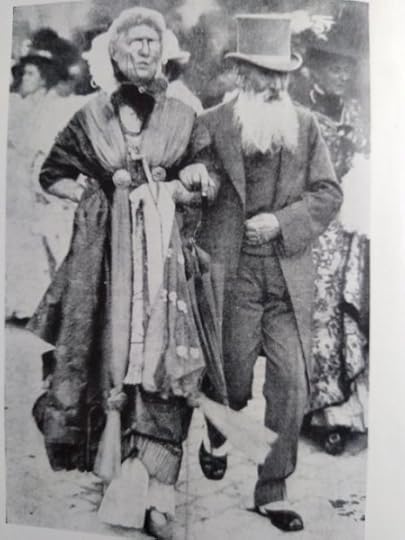
Other than that? I’ve listening to Martin Carthy interviews and tributes, while doing wooden jigsaw puzzles.
Artifact delighted me with a mechanical griffin, very steampunk. I wasn’t absolutely in love with the picture, but as I
it has real turning gears embedded, and a key to wind them! It reminded me fondly of the one of the triumphs of GBBO, back in the day: Andrew’s Leonardo da Vinci train of cogwheeled meat pies.
If anyone wants to do a working Antikythera jigsaw, I am first in line to buy one.
Nautilus, meanwhile, has been turning up in the puzzle club, and pleasantly surprising me. Their whimsies are a little gingerbreadish in silhouette, but generous and witty. Their John William Waterhouse Miranda includes the duke’s daughter herself, a pointy-hatted Prospero, a mermaid, improbable fishes, lots of seaweed, and a little scene: clouds with lightning bolts, a sinking ship, three gulls wheeling and settling on the wreck, and Ferdinand (I suppose) struggling in the waves. Alas, no Ariel nor Caliban.
What just came in was their Walter Crane Neptune’s Horses, with (among other things) the eponymous god and two sirens (one with a lyre).
The choices at Liberty are getting harder. The problem is that they’ve spoiled me. Quite a few of the remaining images that I love best (Vermeer! Bruegel! Botticelli!) were designed in Lynon Aksamit’s prentice days, before he had quite developed his cutting style, before his characters had character. I’m finding fewer puzzles like Sight, where the cut and image both are fabulous. So: gorgeous painting, and a timid little handful of whimsies in rubber-bandy shapes; or absolutely brilliant whimsies (remember that lobster? like that) but with meh images. I ended up getting that Story Map of France instead of the 1576 Map of Paris I’d had my eye on, sheerly for the stunning whimsies. What I've taken to doing, instead framing and filling in, is to find all the whimsies first, and let the puzzle coalesce around them. I still leave the best for last.
And now I’m circling a merely fair contemporary painting of Portofino, the sort of thing you’d find in an upscale souvenir shop, because I fell in love with the bluegreen sailboat and the harlequin cat. Not to mention the children bowling the hoop and the gramophone that might indeed be a morning glory. They’re not only lively, witty silhouettes, but the designer knows just where to place them for the color and shading.
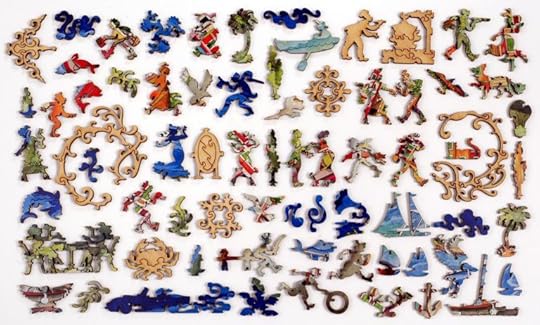
Nine
Remember my Boskone conversazione with Michael Swanwick? We talked about Townsend Warner, Stella Benson, P. L. Travers, Hope Mirrlees, and Tove Jansson. Most enjoyable. Marianne Porter has agreeably proposed to publish “The Lonely and the Rum” as a chapbook, so I spent several days turning all my ums and ers and grammarless babble into sentences. I’ve never had to edit what I actually say before, and it’s sobering how incoherent I sound to myself, with here and there a flash of inspiration.
(Hey, did any of you know there’s a Jansson biopic out there? Finnish not Hollywood, thank heavens. Anthony Lane liked it, but I’m afraid to look. I'd rather not see her life messed with)
Straight after I turned that transcript in, I was asked to do a Scintillation Discord, snarking on Oxfordians. I can do that without prompting, gleefully. To my delight, one of the other speakers was
![[personal profile]](https://i.gr-assets.com/images/S/compressed.photo.goodreads.com/hostedimages/1491408111i/22407843.png) rushthatspeaks
on his 365 Books project. What a joy! If you haven't seen it,
rushthatspeaks
on his 365 Books project. What a joy! If you haven't seen it,
![[personal profile]](https://i.gr-assets.com/images/S/compressed.photo.goodreads.com/hostedimages/1491408111i/22407843.png) rushthatspeaks
read and reviewed a book a day for a year. Brilliant and various.
rushthatspeaks
read and reviewed a book a day for a year. Brilliant and various.And still more writerly rush: I had to compose my panel-choices for Readercon, which essentially means guessing what shape a panel might take and then doing a bit of it, which is like auditioning for an unwritten play, or playing solo mixed doubles on a netless tennis court. Oof. There were two or three ravishing topics on offer, but we’re rationed to just one (if any at all) this year.
I’ve come far enough out of my pandemic hermitude to do play-readings over at the Scintillation Discord. So far I’ve been handed real plums: Thomasina in Act II of Arcadia, Margaret in Dear Brutus, and both Touchstone and Phebe. An idle conceit: Shakespeare’s plays were in conversation with other plays of the period, and I wonder if Audrey weren’t a parody of some grand Gothic tragedy queen?
Really, I tell myself, the pandemic has slowed down now, I can stop buying books and raising cromlechs and hill forts of them round me for protection, but irresistible titles keep turning up, books on the philosophy of color and celestial geometry and synesthesia and Greek amulets and the Annunciation in painting and butch and Bosch and William Morris’s Icelandic diaries.
Oh, and speaking of pre-Raphaelites, I’ve loved Three Houses, Angela Thirkell’s memoir of childhood, for absolute ages (keeping up with the Burne Joneses and the Kiplings), but I hadn’t read her Barsetshire novels. They’re all free on Faded Page, so I downloaded a bunch of the thirties ones. (I like digital books at meals, as it doesn’t matter if I slop sauce on them.) As many of you know, they are rather delicious: dry, gentle social satire, like cosies with marriages instead of murder.
And by the way, the grand-daughters of pre-Raphs do write some treasurable memoirs. Diana Holman-Hunt’s My Grandmothers and I gives us a twenties childhood, shunted between a country-house socialite too parodic even for the BBC and the painter’s mad, miserly, imperious relict. Here are the Holman-Hunts leaving a royal garden party in the 1890s, when Grand was somewhat less eccentric.

Other than that? I’ve listening to Martin Carthy interviews and tributes, while doing wooden jigsaw puzzles.
Artifact delighted me with a mechanical griffin, very steampunk. I wasn’t absolutely in love with the picture, but as I
it has real turning gears embedded, and a key to wind them! It reminded me fondly of the one of the triumphs of GBBO, back in the day: Andrew’s Leonardo da Vinci train of cogwheeled meat pies.
If anyone wants to do a working Antikythera jigsaw, I am first in line to buy one.
Nautilus, meanwhile, has been turning up in the puzzle club, and pleasantly surprising me. Their whimsies are a little gingerbreadish in silhouette, but generous and witty. Their John William Waterhouse Miranda includes the duke’s daughter herself, a pointy-hatted Prospero, a mermaid, improbable fishes, lots of seaweed, and a little scene: clouds with lightning bolts, a sinking ship, three gulls wheeling and settling on the wreck, and Ferdinand (I suppose) struggling in the waves. Alas, no Ariel nor Caliban.
What just came in was their Walter Crane Neptune’s Horses, with (among other things) the eponymous god and two sirens (one with a lyre).
The choices at Liberty are getting harder. The problem is that they’ve spoiled me. Quite a few of the remaining images that I love best (Vermeer! Bruegel! Botticelli!) were designed in Lynon Aksamit’s prentice days, before he had quite developed his cutting style, before his characters had character. I’m finding fewer puzzles like Sight, where the cut and image both are fabulous. So: gorgeous painting, and a timid little handful of whimsies in rubber-bandy shapes; or absolutely brilliant whimsies (remember that lobster? like that) but with meh images. I ended up getting that Story Map of France instead of the 1576 Map of Paris I’d had my eye on, sheerly for the stunning whimsies. What I've taken to doing, instead framing and filling in, is to find all the whimsies first, and let the puzzle coalesce around them. I still leave the best for last.
And now I’m circling a merely fair contemporary painting of Portofino, the sort of thing you’d find in an upscale souvenir shop, because I fell in love with the bluegreen sailboat and the harlequin cat. Not to mention the children bowling the hoop and the gramophone that might indeed be a morning glory. They’re not only lively, witty silhouettes, but the designer knows just where to place them for the color and shading.

Nine
Published on May 30, 2021 19:24
May 21, 2021
Deep rooted, ever green
Happy 80th birthday to the incomparable Martin Carthy! Musician, mensch, traveller, scholar, and a quintessential voice of English folk.
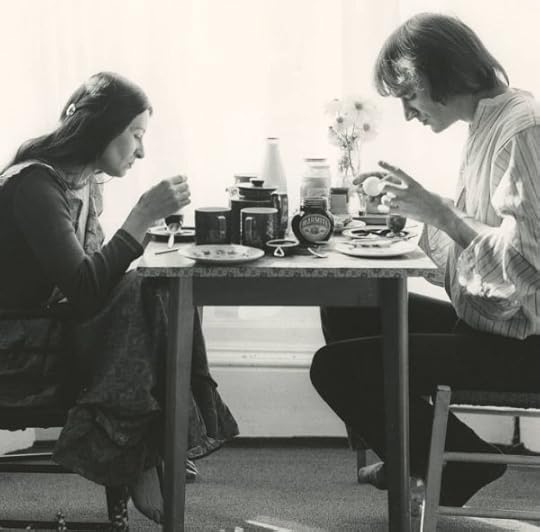
Nine

Nine
Published on May 21, 2021 11:29
Greer Gilman's Blog
- Greer Gilman's profile
- 42 followers
Greer Gilman isn't a Goodreads Author
(yet),
but they
do have a blog,
so here are some recent posts imported from
their feed.



